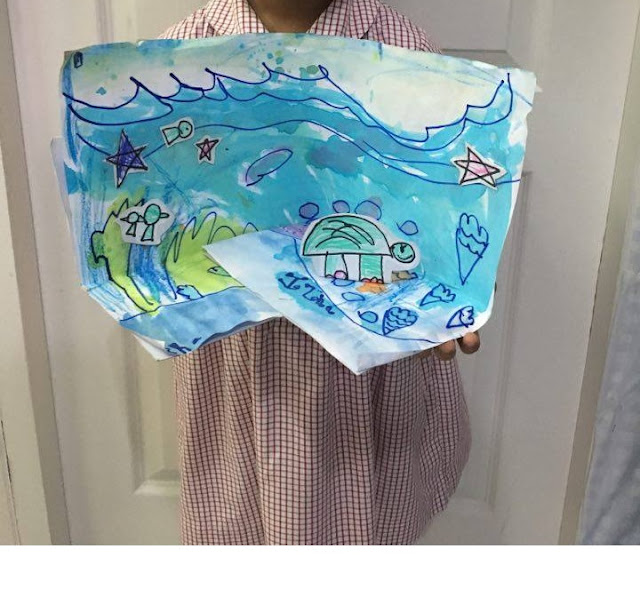Expert Teacher'n
Today I want to talk about 'expert teachers'. What is an expert teacher? Despite what you might think, an expert teacher does not necessarily have to be an adult. No way. Expert teachers can be little people--people who have been on the Earth for only a couple of years. Little people make fantastic teachers. So often we get stuck in the mindset of valuing only adults as educators.
"Have teaching license--will educate the masses".
This kind of thinking would be misplaced.
This week I asked my students to reflect on the expertise of the students who came before them.
Check out this great work from last year's Potoroos:
When showing their work this year's Potoroos, I asked them two simple questions:
What is the habitat?
How do you know?
The first question asks for a singular response. The second question asks for abstract reasoning. It asks for students to give evidence. It requires that students seek the clues that the artist has given them.
" I think this is the ocean. I can see there is a lot of water. It looks like there are jellyfish. It looks like there are sharks. There is seaweed."
" I think this is the forest or the rainforest because there are a lot of trees. It looks like bunnies live there. That would make it a forest."
"I think this is the arctic. It looks cold. There is a penguin. There is a polar bear. there is ice."
" I think this in the ocean. It looks like there are sharks. I can see that the bottom is colored blue."
After reviewing the works of our expert teachers, this year's Potoroos set about making their own habitats. Students were much more conscious of the choices that they made when they were drawing because they had seen that previous students left specific clues of their given habitats.
We used photos and animal figures for inspiration:
This project serves as a final assessment. During this assessment students were asked to describe the features of places and animals. We used descriptive language to talk about our finished products. Students were asked to produce evidence in their work to prove that they were talking about their respective habitat.
This years students will serve as expert teachers for the new students who arrive to K2 next year! Never underestimate the capabilities of your own students!
Until next time learning buddies!
Sam
"Have teaching license--will educate the masses".
This kind of thinking would be misplaced.
This week I asked my students to reflect on the expertise of the students who came before them.
Check out this great work from last year's Potoroos:
When showing their work this year's Potoroos, I asked them two simple questions:
What is the habitat?
How do you know?
The first question asks for a singular response. The second question asks for abstract reasoning. It asks for students to give evidence. It requires that students seek the clues that the artist has given them.
Student: " I think this is the arctic. I can see ice. I can see a penguin. I can see a polar bear. There are no trees."
" I think this is the forest. I can see an owl and trees. I can see birds. There is water."
" I think this is the ocean. I can see there is a lot of water. It looks like there are jellyfish. It looks like there are sharks. There is seaweed."
" I think this is the forest or the rainforest because there are a lot of trees. It looks like bunnies live there. That would make it a forest."
"I think this is the arctic. It looks cold. There is a penguin. There is a polar bear. there is ice."
" I think this in the ocean. It looks like there are sharks. I can see that the bottom is colored blue."
After reviewing the works of our expert teachers, this year's Potoroos set about making their own habitats. Students were much more conscious of the choices that they made when they were drawing because they had seen that previous students left specific clues of their given habitats.
We used photos and animal figures for inspiration:
Look at that amazing concentration and writing posture! Beautiful!
First students crafted their environment. Second they created the animals. To make the image stand out, the students used permanent makers to create bold black or blue lines. Then, we went over the images with crayon and watercolors. The permanent marker does not bleed.
As a teacher I love the fact that everybody has created their own amazing product. This is a 'student made product' from start to finish. It celebrates the learners that we have become. I couldn't be prouder. I love my amazing learners!
Look at our oceans! This was the most popular habitat diorama!
...or the arctic?
Are you as smitten as I am?
This project serves as a final assessment. During this assessment students were asked to describe the features of places and animals. We used descriptive language to talk about our finished products. Students were asked to produce evidence in their work to prove that they were talking about their respective habitat.
This years students will serve as expert teachers for the new students who arrive to K2 next year! Never underestimate the capabilities of your own students!
Until next time learning buddies!
Sam


























Comments
Post a Comment